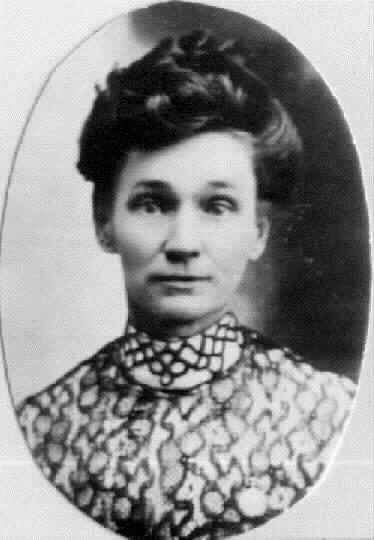(The following is a life sketch of Emma Mariah Tolman. Taken from “Benjamin Hewitt Tolman: Brother Pioneer, Husband, Father” by Dawnine T Mills Johnson, First Edition, Family Heritage Publishers, 2014, pages 5-1 to 5-13.)
Emma Mariah Tolman was born in Brigham City, Utah, November 10, 1856*. She was the youngest of three children born to Benjamin Tolman and Sarah Jane Angell Tolman. Her siblings were Benjamin Hewitt Tolman II and Polly Jane. When she was a little over thirteen months of age, her father died (December 14, 1857). She went with her mother, brother, and sister to live with her grandparents, Truman O. and Polly Johnson Angell.
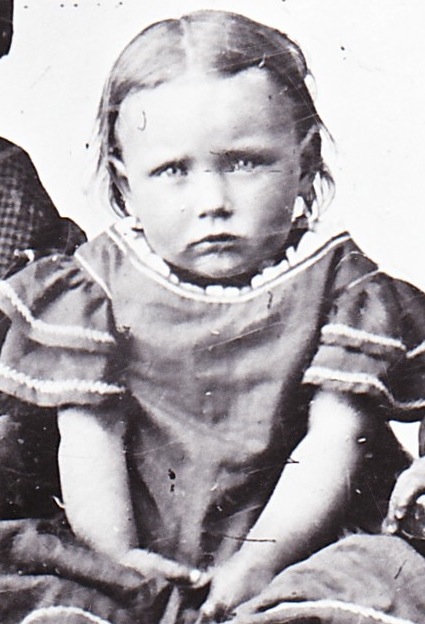
When Emma was 4 years old, her mother married Jarvis Johnson (March 9, 1861). Emma was 12 years old when her mother died (March 21, 1869). Emma with her brother and sister went back to live with her grandparents in Salt Lake City for many years. She also spent time in Grantsville where her Aunt Mariah, her namesake and her mother’s sister lived. She created beautiful needlework as well as clothing throughout the rest of her live.
On March 1, 1875, Emma Tolman, age 18, was married to William Edward Hyde in the Endowment House at Salt Lake City. William was born July 20, 1853 in San Bernadino, California, to William Hyde and Angeline Harris. For three years (1875-1878) the newlyweds made their home in Salt Lake City. Two of their children William Benjamin (July 16, 1976) and Winnifed (December 4, 1878) were born there.
From Salt Lake City they moved to Juab County, living four years (1878-1882) there on a farm at what was known as Chicken Creek, later to be known as Levan. There they had two children born to the family – Emma Louise (November 27, 1879) and Truman Edward (January 20, 1882). While living at the Chicken Creek farm, disaster in the form of fire visited them. The children in their play had set fire to the hay stacks, burning stacks, barns, home and all out buildings, together with a number of livestock, thus leaving them homeless and with nothing to start a new home.
Shortly after this the Hyde family was called by the church authorities to join several other families in the settling and building the little town of Honeyville. They made Honeyville their home for five years (1882-1887). There they had two children born to them–Esther Jean (1884) and Angeline (July 28, 1887). While in Honeyville, they were again visited with sorrow and disaster. An excursion to the Logan Temple had been planned and Emma was among those going to do Temple work. Since her husband was away from home, it was necessary to leave the five children in the care of an aunt or a neighbor. (There are differing accounts as to who the caregiver was.) Truman, the little four year old son, in attempting to follow his caregiver to the store one day, was in some manner diverted from his purpose and followed the railroad tracks for a short distance. Becoming weary, he sat down on the tracks and soon fell asleep. The approaching train failed to arouse him and his little body was cut and mangled past recognition and of course his life was snuffed out instantly (July 30, 1886).
In late 1887, William and Emma Hyde and their five children were called by President Brigham Young to assist in colonizing San Juan County. They traveled on the train as far as Thompson, Utah, where they were met by William’s brother Ernest Hyde with a team and wagon in which they were to continue their journey for another 150 miles before reaching their destination. They arrived in a terrific storm, which turned to heavy snow and a blinding blizzard before they reached the high lands of San Juan. They lost their way in the snow several times. After long weary hours they took refuge in a little abandoned cabin, half buried in the deep drifts. It was a small one-room cabin with a fireplace to offer the weary travelers warmth and cheer, and it had been built to give shelter to a troop of soldiers who had camped there before. This cabin was located at what is now known as South Creek and is just southwest of the present site of Monticello. What comfort and cheer that lonely cabin and crude fireplace offered to the weary and frozen travelers. After a few days rest they resumed their journey to Bluff, arriving there the last of November.
Bluff was to be their new home for only a few months, but those months were happy ones. Once more Emma took up her trade as dressmaker, and found ample uses for her genius along that line. During that winter she kept busy fashioning the then stylish bustles, polonaise, and “waterfalls” for Bluff’s young women. She not only made dresses but made and trimmed their hats, and occasionally sewed buckskin suits and jackets and gloves for the men.
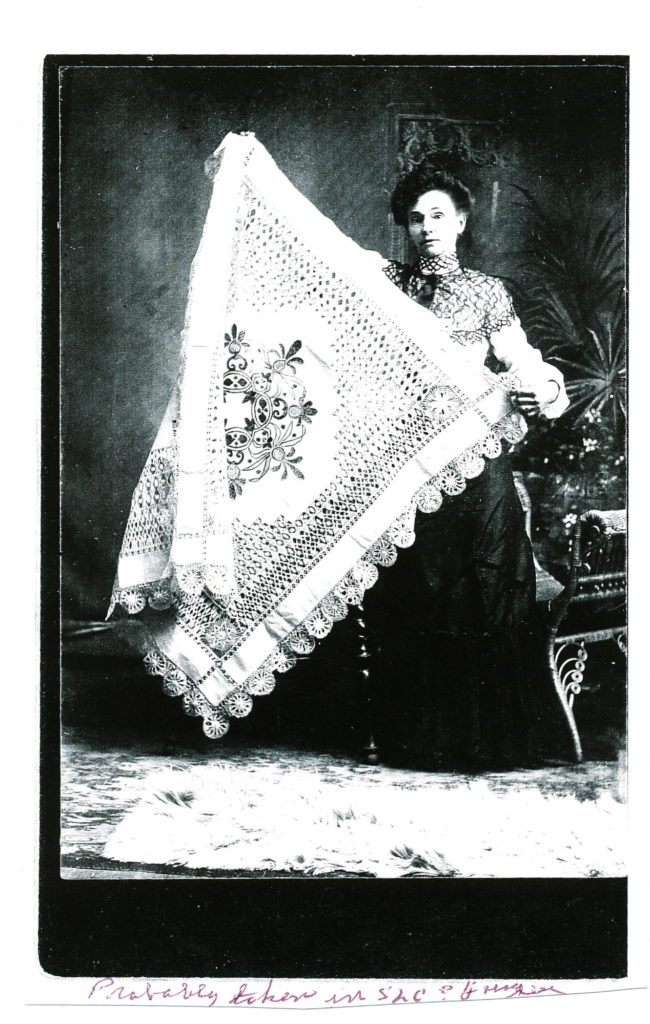
Sometime in January or February, the Quarterly Conference was held at Bluff, Apostles John Henry Smith and Brigham Young, Emma’s uncle, were in attendance. These conferences were events to be looked forward to with a great deal of pleasure. It was during one of these meetings that a rather humorous and exciting incident occurred to her family. While the three older children were left at home this breezy afternoon, kite making became the past-time of the children. The oldest boy constructed a kite of monstrous proportions which became troublesome and unmanageable in the wind. Deciding to tie more “tail” to the kite, he called his smaller sister to his assistance. Being afraid she would loosen her hold on the kite if he let her hold it, he tried mooring the monstrous plaything by tying it around her waist, then tying a big flat iron to her also. Hardly had he gone to find more tail for the kite, than a gust of wind lifted kite, flatiron and child from the ground and wafted them quite jauntily off toward the cliffs. Luckily she came in contact with a high “stake and rider” fence where the frightened, screaming child managed to cling while the two other children ran, white-faced, to the rescue. With the kite being more than the three children could manage, it became necessary to cut the cord and lose the kite, much to the despair of the boy.
In March 1888, the Hyde family set out again to seek a new home, this time they went to Monticello. As once before, they made the trip in a blizzard. Usually two days were required to make the trip, but on this occasion, they were much longer than usual. The eight month old infant, Angeline, contracted pneumonia the first day out, and they were forced to make camp in a grove of trees to give care and treatment to the child. The men of the party made a shelter from the storm by piling cedar branches in a semi-circle and stretching a wagon cover over it to keep out the snow. They camped in this crude shelter for two days before resuming the journey.
Three other families had preceded them to the new settlement; the Hyde’s made a happy fourth in the new little community. The north wind was blowing a gale and carrying snow with it. They had no shelter to live in except the covered wagon in which they had arrived. As soon as the wind and snow abated, Ed gathered cedar bows [sic] and constructed a crude shelter for his family. That spring all the men of the new community planted five acres of wheat, then went to the mountains to get out logs so that each man could build a one room house, which had a dirt roof and floor. The new log house was a one room mansion with a dirt roof and the ground for a floor. What a scramble a little shower caused among the inmates of the household: Leaking roofs brought forth pots, pans, kettles, and any kind of container to be distributed about under the leaks to save beds and furnishings from the dampness. The most prized luxury in the village that summer was the old Charter Oak cook stove belonging to Emma Hyde. All of the four families made use of it until their own stoves could be brought from Bluff.
Emma’s early training now came in handy in fashioning buckskin gloves and shirts. She and her husband sang and performed in amateur plays.
“The first winter in Monticello will always be remembered with feelings of tenderness by those who were snowed in. Among those four families, feelings of brotherly and sisterly love grew and bound them together. For Christmas they met at the home of John E. Rogerson, and each family provided part of the meal. After the dinner was over and the dishes were washed and each sister had picked up her plates, knives, forks, and spoons, the fun commenced. William Adams with a big shillelagh danced and sang an Irish song. Emma Hyde, draped in a lace window curtain stepped to the highland fling; she being dressed to represent a fairy. Edward Hyde, not to be outdone by his wife, sang and acted out the song, “I’m Not As Young As I Used To Be.” Hours later after young and old had had an opportunity to dance, everyone said a “good night” and a “God bless you,” and the first Christmas in Monticello ended.”
More families arrived during the summer to swell their numbers and many were the good old social times spent among this group of new pioneers. Good crops were raised that year assuring an adequate supply of grains and vegetables for the long winter ahead. How thriftily those housewives saved the corn shucks to fill the mattresses for the beds. Winter came early that year, and was so severe that it prevented the farmers from getting their wheat to the mill in Mancos, Colorado. Consequently, that winter the bread for the entire community was made from wheat that was ground in a small coffee mill, which had been brought from Honeyville for this purpose.
Not long are the Latter-day Saint families without their religious organization and gatherings. It was so with this handful of people. Soon they had their Auxiliary Associations all organized and functioning. For the first year the meetings were held in the different homes. When the Sunday School was organized, Emma Hyde was its first Secretary and Treasurer. She also became an Executive officer in the Primary and a teacher in the Relief Society, so there was plenty to keep her busy and happy. Often she was called to help care for the sick and to make the clothes and help prepare the dead for burial.
During their second year in Monticello, Angeline was laid [sic] out as dead, from a severe attack of whooping cough. When her father was called in to check her body, he thought he saw a slight movement in one of her fingers, so he pried her teeth open and poured some brandy down her throat. This irritates the mucous membranes, causing her to cough and catch her breath. She was then very much alive.
William was much sought after during the early epidemics of typhoid and smallpox, because of his understanding of medicine. He set broken bones and extracted teeth when necessity arose, with any kind of crude instruments that would clamp over the teeth. He was also one of the eighteen original stockholders of the Blue Mountain Irrigation Company. The object of the company was to engage in the business of constructing irrigation canals to commence the manufacture of lumber, to engage in the business of home manufacture, dairying, farming, merchandising and stock raising.
Those early days of pioneering in Monticello were hectic ones at times, for the few families gathered here. The lawlessness of the cowboys from nearby cattle ranches, and the occasional uprising of the Indians, made life for these people a constant strain and worry. It became a common occurrence for drunken and irresponsible cowboys to play at “shooting up the town,” to use their own phrase; and hearing the whoops and yells of approaching cowboys was a signal to the settlers to put out their lights and sit in darkness, to forestall an attempt to shoot out the lights through the windows. It is said that in those days, in the Hyde home there was always a space left open between the logs of the house, where Ed Hyde kept his gun pointed at marauders as a protection for his home and family. However, the cowboy menace was only a part of the worries of this people.
There were also the Indian troubles to contend with. At one time, there arose a misunderstanding among the Indians, their Agent in Colorado, and the settlers. The Indians understood the Agent had promised them the Monticello country for a reservation, and then came into the little town quite frequently, frankly, and boldly to make their choice of the dwellings they would occupy when they had succeeded in “running the Mormons off their reservation.” A great Council meeting of the prominent Chiefs was called to take place at Monticello. How vividly was the incident recorded in her mind for all time the night “Old Wash” appeared at Emma Hyde’s home, in the absence of her husband, and informed her that the big “Pow Wow” was to be held in her home. Not daring to refuse admittance to that band of stolid Chiefs, yet in terror for herself and her family alone in the house, she opened her home to them. She gathered her family together in the kitchen, and they sat through the long night awake and fearful, while the noted Chiefs occupied the one other room in weird and noisy “pow wow” until sunrise. Among the Indians participating in the council meeting were such noted Chiefs as Ignacio, Redrock, Hatch, Benow and Bridger Jack. During that dreadful night, thinking to create a friendly feeling among the red men for the white settlers, Emma cooked food, consisting of baked potatoes, squash and venison and served it to the assembled Indians. All through the night, at regular intervals, old Wash would come noiselessly to the door of the kitchen and inquire, “Squaw, you scairt?” and then he would assure her that no harm would befall them, because Ed Hyde was their good friend. Ed was able to speak the Indian language and they looked upon him as a white counselor.
They had four children born in Monticello—Ray Lynn (26 April 1891), Harriet Parthenia (5 January 1894). Twins girls, Polly Josephene and Sarah Jane, were born in 1896 and died shortly after being born. Because there was no cemetery, the twins were buried out in the waste country that had become hay fields.
There followed several years of severe drought in the land. The earth became so dry that the wind would blow the soil from the fields leaving the seeds uncovered, and crops were a complete failure. During the time of the drought in 1898, the Hyde family moved to Grand Junction, Colorado, where they lived about a year before returning to Monticello. The 1900 Census shows them living in Monticello. Emma Mariah was listed as a dressmaker.
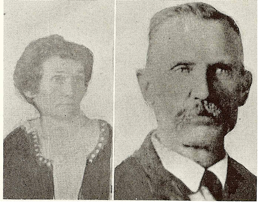
Picture of Emma Mariah Tolman and her husband taken from Saga of San Juan by Cornelia Adams Perkins, Marian Gardner Nielson, and Lenora Butt Jones, published by San Juan County Daughters of Utah Pioneers, 1859.
In 1903 Ed, Emma and part of the family moved to Logan, Utah, at which place they were living when death claimed the husband and father in March, 1905, leaving Emma with two small children to care for. After a year she returned to Monticello where she engaged in dressmaking and needlework, also achieving some success with her oil paintings. The 1910 census showed Emma listed as an artist. In 1907 she married George Francis Perkins in Monticello and he died January 22, 1914. She then married Edwin H. Singley in Monticello December 4, 1916.
In April 1917, war was declared by the United States, and in November of that year, she like so many other brave mothers, saw her youngest son called into the service overseas. It was a heart breaking circumstance for her, but in her patriotism she bade the family to shed no tears for he was only one of many boys and must not shirk this duty. She bolstered up her own courage by insisting, “I’m proud to be the mother of such a soldier boy.” But it left her alone in her old age, all the other children being married and with families of their own.
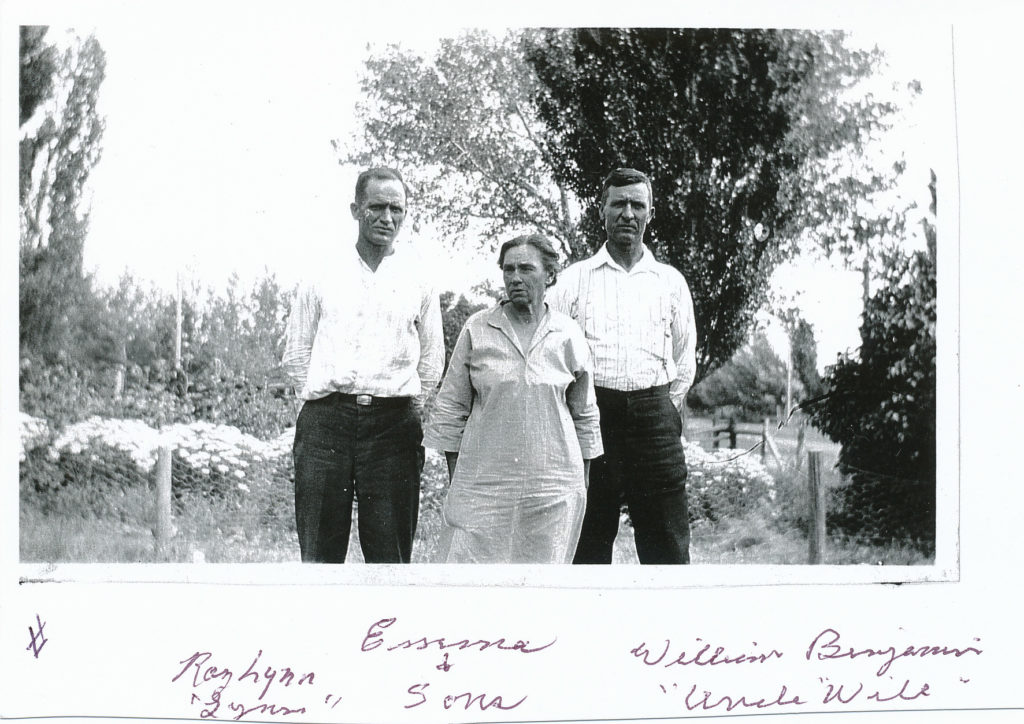
Her entire life was one of hardship and struggle, but she seemed to love the hard times along with the rest of her pioneer associates. Hers was truly a useful and eventful life, and on August 15, 1930, after two years of tragic suffering from ill health, she died in Monticello at the age of seventy-two. She was the mother of ten children and at the time of her death she had forty-two grandchildren and thirty-one great grandchildren.
[*Author’s Note: There are major problems with Emma Mariah Tolman’s actual name and her birth year . It seems she changed the spelling of her middle name by dropping the “h”. There is a history of Emma Marian [should be Mariah] Tolman Hyde submitted to the Monticello Camp Daughters of Utah Pioneers, San Juan County, Utah, showing the birth date as November 10, 1858. This date of November 10, 1858 is also listed on her grave marker. Unable to obtain a copy of her birth certificate, several other items were used to disprove the “1858” date and that her actually birth date was November 10, 1856. It is known that her father died December 14, 1857. If she had been born in 1858, it would have been 11 months after her father died. Also, the 1880 Census shows Emma and her family living in Juab County, Chicken Creek and on June 1, 1880, Emma Mariah was 23 years old, making the year she was born as 1856. Her death certificate shows her birth as 1857. Her marriage certificate for when she married Edwin H. Singley on December 4, 1916 shows her age as 55, which would mean she was born in 1861.]
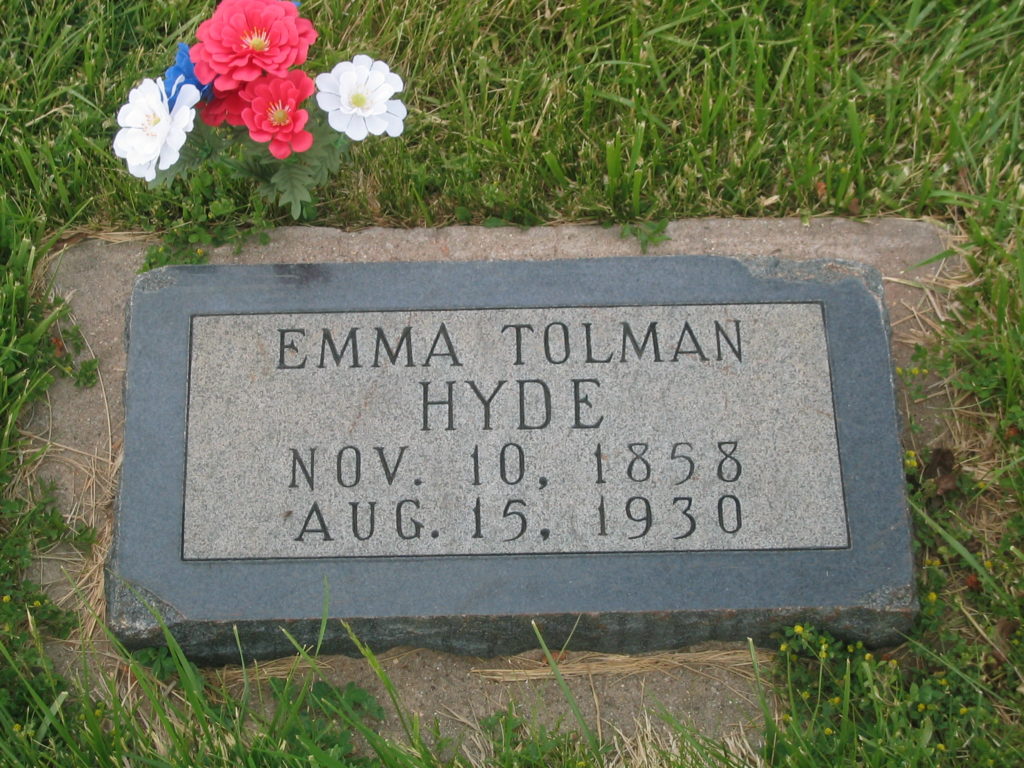
Pictures taken of grave marker in Monticello City Cemetery (2007)
Visit FamilySearch to learn more about Emma Mariah Tolman and other ancestors. Also visit the Thomas Tolman Family Organization to find out how you can get more involved in family history.


